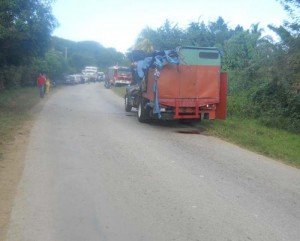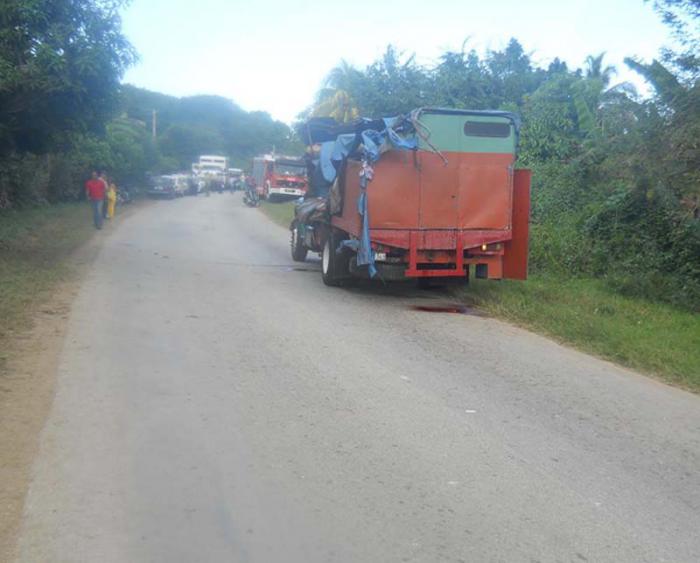Eduardo Palomares Calderón 1
Tragic Dawn at Ti Arriba
- English
- Español
Violations and irresponsibility mark the tragic dawn at Ti Arriba
The creation of some kind of procedure to grant self-employment licenses for public transportation based on the same requirements that public bus drivers must meet remains an unresolved matter.
Author: Eduardo Palomares Calderón | palomares@granma.cu /
January 11, 2016
A CubaNews translation.
Edited by Walter Lippmann.
Santiago de Cuba.— Serious violations by any of the parties involved always lay behind every big accident, the experts in charge of clarifying them usually say. And the crash at Ti Arriba in which 13 people were killed and 17 others injured was no exception.
In less than 72 hours following its publication in Granma’s website, the news of what happened last December 28 at 6:50 a.m. had more than 12,300 visits and around 100 comments by readers, mostly requesting information about the cause of the accident and who was responsible, convinced of the lesson to be drawn from it. 
The left side of the truck in which thirteen La Maya-bound passengers ended up dead was totally destroyed. (Photo: Provincial Transit Authority)
Data provided by the Ministry of the Interior have it that the blame for what happened lies with La Maya resident Reynier Dip González, 26, who was driving a truck bound for Guantanamo that eventually went onto the lane on which Andrés Gómez Affarriba was driving his own truck from Yerba de Guinea to La Maya.
After avoiding a head-on collision —which allowed each of the drivers to survive unscathed— Reynier’s vehicle’s left side bumped against Andrés’s, leaving it a wreck all the way through the middle of the structure.
As a result, 13 people were killed instantly (seven women, six men, and two boys of 7 and 14) and many more injured, all of whom were on board the Zil-130 truck headed for La Maya. A valid remark, since at first some of the victims were mistakenly said to have been traveling on the other truck.
Provincial Transit Authority’s second-in-command, First Lieutenant Yoandris Rodríguez González, warns that in light of their great responsibility every self-employed owners and drivers of vehicles for public transportation are expected to avoid any violation of Act 109 of the Road Safety Code.
This is all the more imperative if we take into account that Juan Alberto Falcón Santana, the owner of the truck trademarked International that usually traveled the Havana-Santiago de Cuba-Guantanamo route employs three drivers, each of whom has lost their driver’s license at some point in the last three years for breaking the aforesaid legislation.
Dip González caused the accident precisely for violating Article 65 (about the obligation of traveling on the right lane when driving on that kind of highway), the same offense that earned him a ticket in the city of Santa Clara exactly one month before. And he was speeding to boot, considering the activity that his vehicle is designed for (speed limit 60 km/h).
Likewise, the investigation revealed the violation of Article 182—vehicles with technical flaws in the braking system are banned from circulation—since the emergency brake failed to work evenly on each wheel and therefore could not stop the truck from sliding onto the opposite lane.
Actually, this accident did not happen by sheer chance, nor was it just “bad luck”: the ticket issued in Santa Clara, plus the fact that this driver had been imposed another three fines that same year for carrying people to excess, parking beside a set of traffic lights, and going through a red light, make it clear that Reynier Dip was not suitable for this job.
Moreover, each of the other two drivers had been given four fines in 2015 for not having a license and registration, driving a vehicle with technical flaws, forbidden circulation, blocking the way, and distraction, among other traffic violations.
No doubt the existence of rules to grant a self-employment license for this occupation based on the same requirements that state-owned bus drivers must meet remains an unresolved matter.
The most serious of its kind in the last ten years in Santiago de Cuba, this accident not only plunged tens of families into mourning, it also sent the province—where millions of pesos have been invested in traffic signs and preventive work in general— to a hardly flattering third place at national level on the list of road fatalities in 2015.
Violaciones e irresponsabilidad en el trágico amanecer de Ti Arriba
El establecimiento de algún mecanismo para otorgar licencias en la transportación de pasajeros por cuenta propia, a quienes cumplan exigencias similares a las planteadas para conductores de ómnibus nacionales, aún es una asignatura pendiente
Autor: Eduardo Palomares Calderón | palomares@granma.cu
11 de enero de 2016 22:01:29
 Destrozado quedó el lateral izquierdo del camión en que fallecen las 13 personas que se dirigían a La Maya. Foto: Unidad Provincial de Tránsito
Destrozado quedó el lateral izquierdo del camión en que fallecen las 13 personas que se dirigían a La Maya. Foto: Unidad Provincial de Tránsito
SANTIAGO DE CUBA.—Violaciones graves por alguna de las partes involucradas están siempre detrás de todo gran accidente, suelen decir los especialistas responsabilizados con su esclarecimiento, y el caso en que fallecieron 13 personas y otras 17 resultaron lesionadas en Ti Arriba, no fue la excepción.
Acaecido a las 6 y 50 de la mañana del pasado 28 de diciembre, la publicación del hecho en la página digital de Granma registró en apenas 72 horas más de 12 300 visitas y cerca de 100 comentarios de lectores, quienes en general solicitaron de modo aleccionador la información sobre sus causas y responsables.
Según detalles facilitados por autoridades del Ministerio del Interior, la responsabilidad corresponde al ciudadano Reynier Dip González, de 26 años de edad y residente en La Maya, quien invadió con el camión que conducía hacia Guantánamo, la senda contraria por la cual circulaba el guiado por Andrés Gómez Affarriba, en dirección a La Maya.
Tras rebasar el frente sin contacto alguno, lo cual propicia que ningún conductor sufriera lesiones, ambos vehículos rozaron violentamente por su lateral izquierdo, quedando destrozado en más de la mitad el correspondiente al que transportaba pasajeros desde Yerba de Guinea a La Maya.
Como consecuencia quedaron sin vida 13 personas en el mismo sitio de la colisión (siete mujeres y seis hombres) incluyendo dos menores de 7 y 14 años, todos los cuales viajaban en ese Zil-130 que se dirigía a La Maya, que igualmente registra la mayoría de los heridos. Valga la precisión, pues erróneamente se relacionaron algunas víctimas al otro camión.
Al aportar tales elementos el primer teniente Yoandris Rodríguez González, segundo jefe de la Unidad de Tránsito en la provincia, señaló que atendiendo a su alta responsabilidad, propietarios de vehículos y conductores acogidos a la transportación masiva de pasajeros por cuenta propia, no deben estar asociados a peligrosas violaciones de la Ley 109, Código de Vialidad y Tránsito.
Revelador de ese imperativo es el hecho de que el camión marca International, propiedad de Juan Alberto Falcón Santana, que habitualmente cubría la ruta La Habana-Santiago de Cuba-Guantánamo, tiene a su cargo tres conductores y ninguno de ellos está exento en los últimos tres años a la suspensión de la licencia de conducción, por infracciones de la citada Ley.
Específicamente, Dip González provoca el accidente al violar el Artículo 65, que en síntesis establece transitar por la senda derecha del eje central de vías de ese tipo; el mismo por el que había sido reportado en Santa Clara otro día 28, pero de febrero último. Además, circulaba a exceso de velocidad para la actividad fijada al vehículo (60 km/hora).
De igual forma, la investigación arrojó la violación del Artículo 182, que prohíbe la circulación de vehículos con desperfectos técnicos en el sistema de frenos, pues el freno de servicio no accionó uniformemente en todas las ruedas y contribuyó al desplazamiento del carro hacia la senda opuesta.
Realmente el accidente estuvo lejos de ser obra de la casualidad o como se dice en cubano “mala suerte”, ya que si junto a la notificación de Santa Clara en el mismo año acumulaba otras tres por exceso de pasajeros, parqueo en zona de semáforos y violación de la luz roja, Reynier Dip carecía de idoneidad para este trabajo.
En cuanto a los dos restantes choferes, cada uno presentaba en el 2015 cuatro multas por viajar sin documentos, desperfecto técnico del vehículo, circulación prohibida, obstrucción en la vía y distracción, entre otras violaciones.
Sin duda alguna, asignatura pendiente constituye en el país el establecimiento de algún mecanismo que establezca en el sector particular el otorgamiento de licencias en esta actividad por cuenta propia, a quienes cumplan exigencias similares a las planteadas para conductores de ómnibus nacionales.
Mayor de su tipo en los últimos diez años en la provincia, además de enlutar a decenas de familias, el accidente ubicó a Santiago de Cuba, que ha invertido millones de pesos en la señalización de sus vías y el trabajo preventivo en general, en el nada halagüeño tercer lugar nacional en número de fallecidos por accidente del tránsito en el 2015.
Subscribe to Blog via Email
| M | T | W | T | F | S | S |
|---|---|---|---|---|---|---|
| 1 | 2 | 3 | 4 | 5 | 6 | 7 |
| 8 | 9 | 10 | 11 | 12 | 13 | 14 |
| 15 | 16 | 17 | 18 | 19 | 20 | 21 |
| 22 | 23 | 24 | 25 | 26 | 27 | 28 |
| 29 | 30 | 31 | ||||


You must be logged in to post a comment.